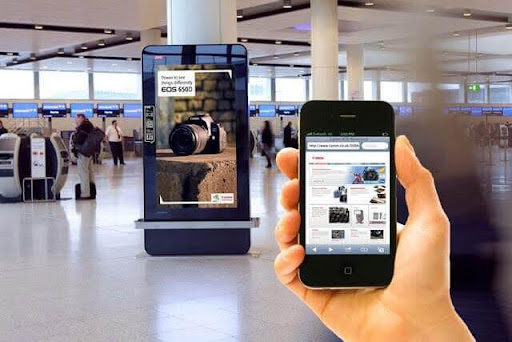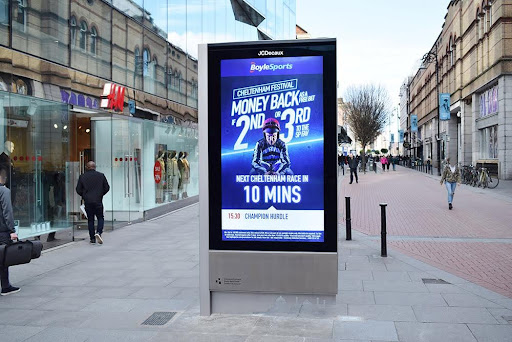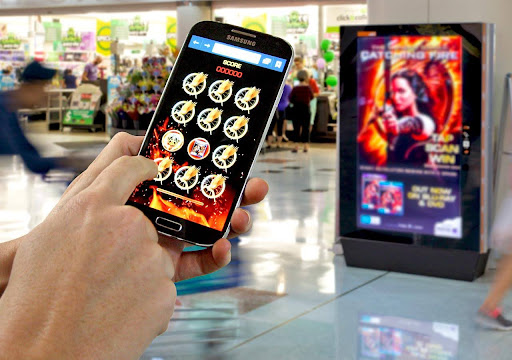
Image source: AdQuick
OOH advertising, a longstanding method, remains potent in reaching consumers. In today’s digital era, it has evolved into a dynamic, automated, and data-powered tool, blending traditional approaches with digital tech to effectively engage audiences and boost sales.
In today’s digital era, the significance of out-of-home (OOH) advertising cannot be emphasized enough. Despite the surge in digital marketing, OOH advertising remains highly relevant. It plays a crucial role in building brand recognition, attracting customers to physical locations, and boosting sales. OOH ads have the advantage of reaching individuals in their everyday environments, whether it’s their home, workplace, or leisure spots, thereby offering broad audience coverage. Additionally, combining OOH ads with digital strategies enhances the effectiveness of marketing campaigns.
The Fundamental of Out-of-Home Advertising
Out-of-Home (OOH) advertising encompasses various methods of reaching consumers when they’re away from home. It spans across billboards, digital displays, bus stops, posters, urban fixtures, and locations like sports arenas and concert venues. OOH advertising proves highly efficient in reaching extensive audiences and promoting diverse products and services.
What Is Out-of-Home Advertising

Image source : google
Outdoor advertising, also known as OOH advertising, is a marketing approach aimed at engaging consumers when they’re away from home. It encompasses various mediums like billboards, digital displays, bus stops, posters, and venues such as stadiums and concert halls. OOH advertising is renowned for its effectiveness in reaching broad audiences and promoting diverse offerings.
A significant advantage of OOH advertising lies in its ability to connect with consumers across various locations. For instance, a billboard can capture attention on a bustling highway, while a digital screen can engage viewers in settings like shopping malls or airports. This versatility enables advertisers to interact with consumers in diverse contexts and throughout the day.
The Benefits of OOH Advertising
One of the primary advantages of utilizing out-of-home (OOH) advertising for promoting a product or service lies in its exceptional visibility, reaching a substantial audience. This is achieved through strategic placement of billboards and other OOH formats in busy locations, ensuring exposure to both drivers and pedestrians.
Another advantage of OOH advertising is its immunity to ad blockers or similar technologies. This ensures advertisers that their message will reach consumers, irrespective of whether they employ ad-blocking software on their computers or mobile devices.
Lastly, OOH advertising offers a platform for immense creativity, enabling advertisers to employ vivid graphics, vibrant hues, and other attention-grabbing elements to captivate consumers. This can prove especially effective in bustling urban settings where consumers are constantly exposed to advertising stimuli.
Out of home Advertising in a Digital World

Image source : pixel Outdoor
In the modern era of digital communication, out-of-home (OOH) advertising encounters fresh hurdles and prospects. The ascendance of digital platforms has revolutionized consumption patterns, necessitating adaptation within OOH advertising to maintain its significance. This segment delves into the influence of digital technologies on OOH, the fusion of digital mediums with OOH, the realm of digital out-of-home (DOOH) advertising, and the evolution of next-generation OOH advertisements.
Impact of Digital on OOH
The OOH advertising sector has been notably influenced by digital media. Despite initial concerns that online advertising would render it obsolete, OOH advertising has demonstrated resilience by embracing shifts in the media environment. Its evolution spans from conventional billboards and posters to encompass digital billboards, interactive displays, and augmented reality encounters.
DOOH advertising has increasingly adopted a data-driven approach, enabling advertisers to pinpoint particular audiences according to their location, demographics, and behavior. This enhancement has elevated the effectiveness and efficiency of OOH advertising to unprecedented levels.
Integration of Digital and OOH

Image source Movia
The fusion of digital and out-of-home (OOH) advertising has unlocked fresh avenues for advertisers to craft cross-channel ad campaigns that drive results. By merging the impact of OOH advertising with the accuracy of digital targeting, advertisers can forge campaigns that are both tailored and captivating. For instance, they can employ geotargeting to exhibit pertinent ads to individuals according to their whereabouts. Furthermore, they can utilize mobile data to re-engage individuals who have encountered their OOH ads through digital advertising.
The convergence of digital and out-of-home (OOH) advertising has expanded the horizons for advertisers to devise cross-channel ad campaigns with higher conversion rates. Through the amalgamation of OOH advertising’s impact and digital targeting’s precision, advertisers can develop campaigns that are not only tailored but also captivating. For instance, they can employ geotargeting to showcase pertinent ads to individuals depending on their geographic location. Additionally, they can utilize mobile data to re-engage individuals who have been exposed to their OOH ads through digital advertisements.
The Effectiveness Of OOH Advertising
The effectiveness of OOH advertising stems from its extensive reach and prominent visibility, making it particularly potent for cultivating brand recognition and reinforcing messages across various media platforms.
DOOH Advertising: The Upgraded Format of OOH Ads

Image Source: Adworld
DOOH ads refer to digital displays capable of real-time updates, enabling advertisers to showcase varying messages based on factors like time of day or evolving circumstances. They can also incorporate interactivity, offering novel engagement opportunities for viewers.
DOOH advertising offers enhanced targeting compared to traditional OOH advertising. Through the utilization of mobile data and other sources, advertisers can pinpoint optimal locations for displaying ads based on their target audience’s behavior. This heightened level of targeting has significantly increased the effectiveness and efficiency of DOOH advertising.
In summary, OOH advertising has evolved to suit the digital era by incorporating innovative technologies and approaches. The fusion of digital and OOH has unlocked fresh opportunities for advertisers, with DOOH advertising emerging as the cutting-edge technology in the OOH ads sector. As technology continues to advance, OOH advertising is poised to maintain its significance within the advertising realm for the foreseeable future.
The Role of Technology in OOH Advertising
As the digital landscape expands, out-of-home (OOH) advertising has undergone adaptations to remain pertinent. A key approach has been the integration of technology into its methodologies, enabling OOH advertising to enhance its precision, measurability, and efficacy.
Inventory and Measurement

Image source : Neuron
Technology has empowered OOH advertising to achieve greater precision in inventory management and measurement. Through the utilization of digital screens and programmatic advertising, advertisers can now procure precise ad spaces and time slots. Consequently, this enables them to target their audience more efficiently while minimizing wastage.
Furthermore, digital screens enable advertisers to conduct real-time assessments of ad performance. They can observe the viewership metrics, duration of engagement, and the resultant actions taken. This information is instrumental in refining campaigns and enhancing future effectiveness.
Targeting and Audiences

Image source : unsplash
Technology has also revolutionized OOH advertising by enhancing targeting capabilities and audience segmentation. By harnessing data and analytics, advertisers can now pinpoint specific demographics, behaviors, and locations for targeted messaging. This enables the delivery of more tailored and personalized messages to the audience. Furthermore, technological advancements have facilitated the creation of dynamic ads, which can adapt based on factors such as time of day, weather conditions, or other external variables. This dynamic nature enhances the relevance and effectiveness of the advertisements.
In conclusion, technology has been instrumental in shaping the evolution of OOH advertising. It has facilitated greater precision in inventory management, measurement, targeting, and audience segmentation. This has resulted in enhanced campaign effectiveness and improved ROI for advertisers. As technology progresses further, it will be intriguing to observe the ongoing adaptations and innovations within the OOH advertising landscape.
The ROI of OOH Advertising
Out-of-home (OOH) advertising has stood the test of time, spanning centuries, and remains a vital marketing asset for contemporary businesses. Despite the dominance of digital advertising, OOH advertising retains its efficacy in reaching broad audiences, particularly when integrated with digital campaigns. Notably, OOH advertising consistently delivers significant returns on investment (ROI) for businesses.
Measuring the Impact of OOH Advertising
Assessing the effectiveness of OOH advertising campaigns presents challenges due to the difficulty in tracking the impact of billboards or posters. Nevertheless, technological advancements have enabled the measurement of OOH advertising effectiveness. For instance, businesses can now monitor impressions, engagement, and conversions by leveraging QR codes, augmented reality, and mobile applications.
As per research conducted by the Outdoor Advertising Association of America (OAAA), OOH advertising yields an average revenue of $5.97 for every dollar invested. This surpasses the ROI of other conventional advertising methods like print and radio advertising.
The Value of OOH Advertising
Out-of-home (OOH) advertising offers a distinct advantage in reaching a wide audience. Unlike digital ads, which can be tailored to specific demographics, OOH ads are visible to anyone passing by, making them highly effective for boosting brand recognition and engaging diverse audiences.
Additionally, OOH advertising presents a cost-effective alternative to other advertising mediums. Unlike digital ads, which often come with hefty price tags, OOH ads tend to be more budget-friendly, making them particularly advantageous for small businesses. Moreover, integrating OOH ads with digital campaigns enables a comprehensive multi-channel marketing approach, allowing businesses to engage consumers across various platforms.
The Future of OOH advertising
With the ongoing advancements in technology and the growing digital landscape, the trajectory of OOH advertising is in a state of constant evolution. Here, we’ll delve into the innovations and shifts that are molding the future of OOH advertising.
Innovations in OOH Advertising
The digitization of ad units in out-of-home advertising stands as a remarkable innovation. With the rise of digital billboards and screens, advertisers now enjoy dynamic and interactive advertising opportunities. Furthermore, these digital platforms offer enhanced viewability and measurement features, enabling advertisers to gauge campaign effectiveness with greater precision.
Another advancement in out-of-home advertising involves leveraging data and technology to deliver targeted and personalized ads. Leading this initiative is Geopath, a non-profit organization offering audience location measurement services to the OOH industry. Through the utilization of consumer behavior and demographic data, advertisers can craft more pertinent and impactful OOH campaigns.
Democratization of OOH Advertising

Image source : OAAA
Previously, out-of-home (OOH) advertising was mainly accessible to large brands with substantial budgets. Nonetheless, the democratization of OOH advertising is altering this landscape. Entities like AdQuick are simplifying the process, allowing businesses of varying sizes to purchase and oversee OOH campaigns. This democratization is fostering increased creativity and diversity in OOH advertising, as smaller brands and businesses introduce their distinct perspectives and concepts.
Media platforms like Movia are contributing to the democratization of OOH advertising by investing in new technologies and ad units. This investment simplifies and reduces the cost for advertisers to develop impactful OOH campaigns. The surge in competition is leading to price reductions, expanding accessibility to OOH advertising for a broader array of businesses.
Trends and Innovations in OOH Advertising
The ever-evolving realm of OOH advertising is constantly influenced by emerging trends and innovations, reshaping how brands engage with their audience. Grasping these trends is crucial for marketers seeking to harness OOH advertising to its fullest potential.
A rising trend involves the growing adoption of data-driven targeting and personalization in DOOH advertising. Advertisers are employing big data and AI to deliver tailored and pertinent content, amplifying engagement and efficacy.
Sustainability is increasingly gaining importance in OOH advertising. Embracing eco-friendly approaches, such as employing renewable energy sources for digital displays or utilizing recyclable materials for billboards, underscores a growing dedication to environmental stewardship.
The integration of OOH advertising and social media is a rising trend that enhances brand messaging. Innovative OOH campaigns aim to be highly shareable, motivating audiences to post about them online, thus broadening the campaign’s reach and influence. A prime illustration is Zendesk’s recent “Break Free” campaign, featuring a drone spectacle at a competitor’s conference. While hundreds witnessed the live drone display, hundreds of thousands viewed it through social media channels.
Conclusion
Out-of-Home (OOH) advertising remains a potent and resilient element of the marketing mix. Despite the dominance of digital media, OOH advertising provides a tangible and influential means of connecting with audiences in physical spaces. Its capacity to embrace emerging technologies and trends guarantees its continued significance and efficacy amidst the ever-changing advertising terrain.
Ranging from conventional billboards to state-of-the-art digital displays, OOH advertising serves as a platform for creativity and innovation. Its adaptability enables diverse strategies, encompassing captivating visuals to interactive experiences that captivate and connect with consumers.
Are you prepared to elevate your advertising campaign? Reach out to Movia experts for a transformative experience.


